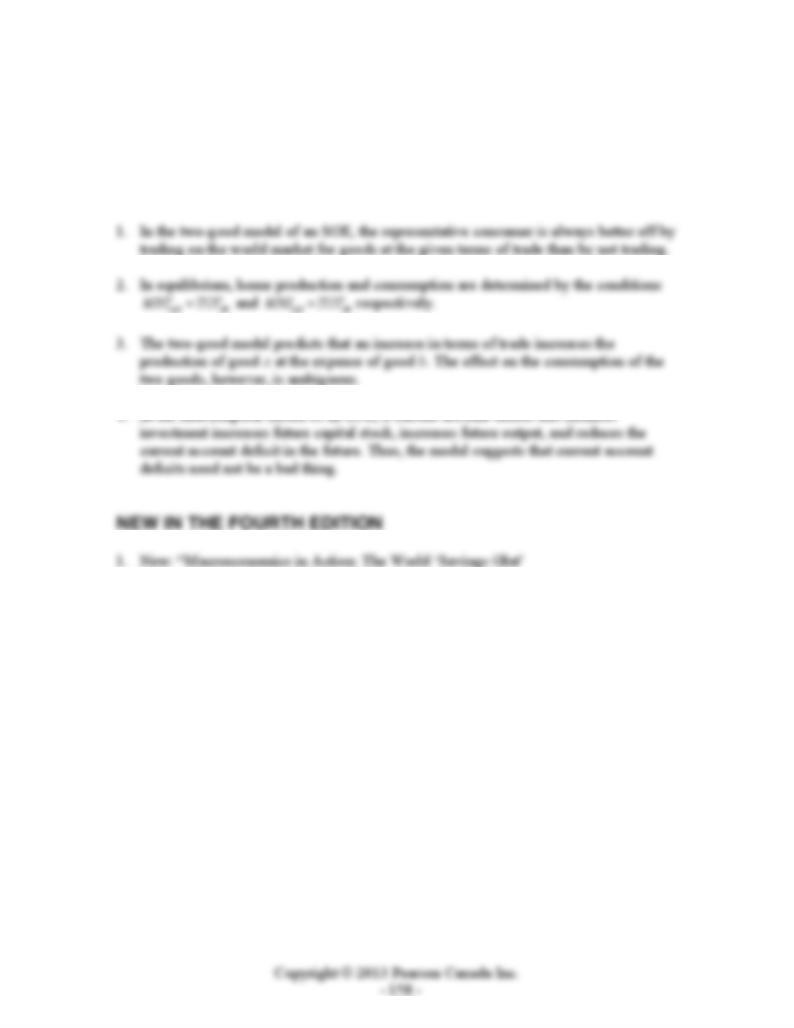
CHAPTER 15
International Trade in Goods and Assets
KEY IDEAS IN THIS CHAPTER
2. All data and graphs have been updated.
TEACHING GOALS
There are two basic aspects to international trade. Trade in goods and services enables a
nation to benefit from comparative advantage. In the absence of trade, competitive
markets allow the economy to reach a Pareto optimum. At this optimum, the marginal
rate of substitution for consumers is equal to the marginal rate of transformation in
production. These marginal rates are reflected in market prices. If we open up an
economy to trade, the country can improve its welfare as long as relative prices under
autarky differ from relative prices in the rest of the world. It does not matter in which
direction this difference works. In either case, the representative consumer can reach an
indifference curve that lies beyond the one reached in the absence of trade. This is the
essence of gains to trade.
The second aspect of trade involves trade in financial assets. A closed economy is
required to exhaust exactly its total output in each period between consumption,
investment, and government spending. An open economy can use either more or less than
the output it produces in each period. Differences between production and absorption can
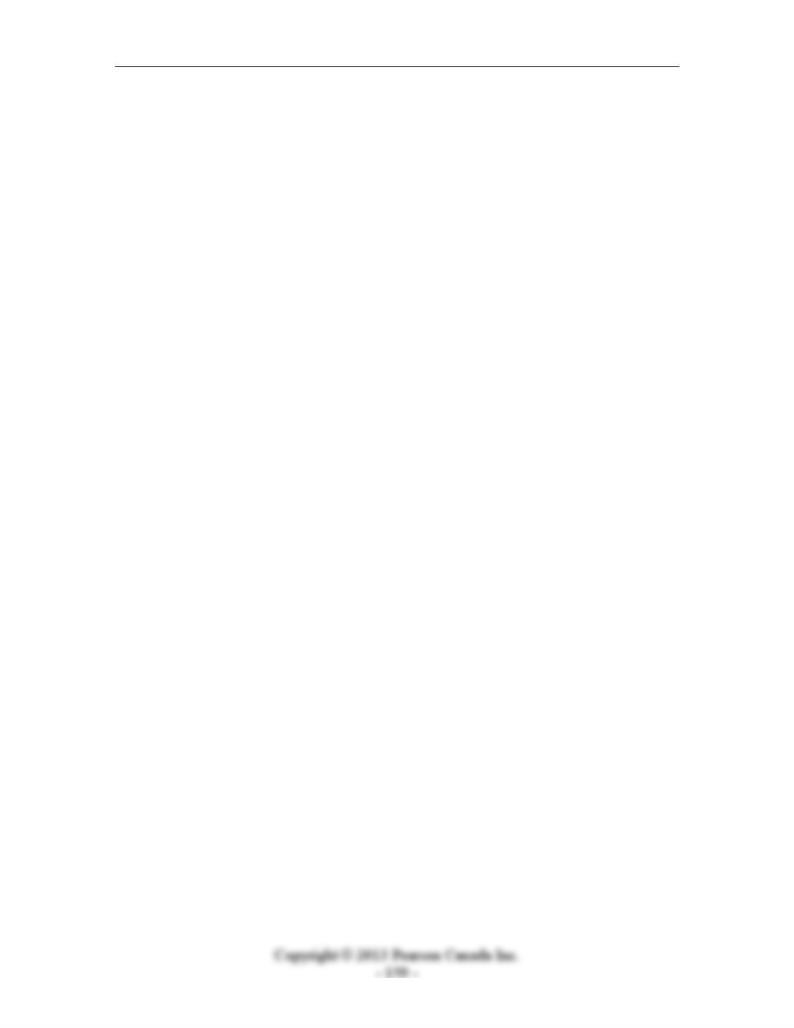
Chapter 15: International Trade in Goods and Assets
occur when the current account is either in surplus or deficit. A common misconception is
for students to think of the current account balance as reflecting competition for sales by
firms in different countries. A better insight into the current account balance results from
considering the additional option for consumption smoothing that arises from borrowing
and lending activities with those in other countries. Clearly, a country that benefits from
running a current account deficit wants to increase its capital stock more quickly than
would be possible in the absence of foreign borrowing.
CLASSROOM DISCUSSION TOPICS
Support for protectionist trade policies comes to the forefront from time to time. Ask
students for arguments that they have heard that rationalize tariffs or quotas. Ask them if
they support such policies, or find the reasons given for protectionist sentiment
compelling. What does fair trade as opposed to free trade mean? Guide them in the
direction of finding market failures in international trade. Distinctions between free and
fair trade only have meaning if there is monopoly power in the markets for traded goods,
or if there are externalities that are complicated by the differing rules of different
sovereign nations. Monopoly power may be involved in the steel and automotive
industries. Is this a concern for students? Trade protection is also proposed because other
nations have more lax environmental restrictions. Don’t we benefit from the decision of
other countries to specialize in dirty industries?
Trade policies usually boil down to attempts by those who are hurt by trade to seek
compensation from those who benefit from trade. What are the likely differences in
relative prices between a closed Canada and the rest of the world? Much of recent
concern has its roots in the fact that the value of skilled labour relative to unskilled labour
is much higher in the rest of the world than it would be in a closed Canadian economy.
Are trade policies a relatively efficient or inefficient means of affecting the distribution of
income? Are students able to see trade policy issues as economists see them? Encourage
students to express their views of trade policies in the language of economics.
Another concern relates to the fact that Canada ran deficits in the current account from
1961 to 1998 (with the exception of 1970, 1982, and 1996, when the current account was
temporarily in surplus). Are students concerned about the balance of payments? Why or
why not? Remind students that current account surpluses and deficits are equivalent to
international borrowing and lending. Is it ever a good idea to try to prevent markets from
functioning in a competitive manner? Be sure they understand that encouraging exports
and discouraging imports cannot solve the problems inherent in the desire to smooth
consumption and expand investment as long as the marginal product of capital exceeds
the world real interest rate.
Another interesting discussion topic relates to foreign ownership of Canadian assets. In
recent years, foreigners have purchased a large quantity of Canadian government bonds.
Remind your students that Mexico, Russia, and some countries in East Asia faced severe
economic problems when foreign investors began withdrawing their money. Could
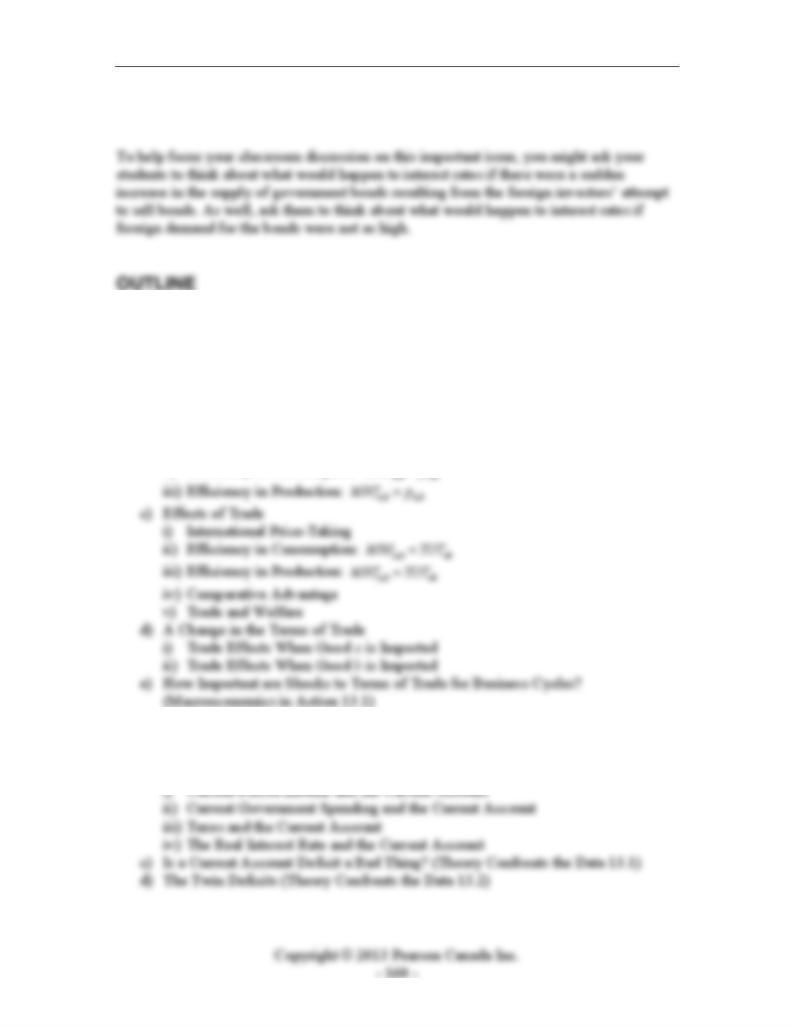
Instructor’s Manual for Macroeconomics, Fourth Canadian Edition
Canada face a similar crisis? What would happen if foreign investors soured on Canada
and sold these government bonds?
1. A Two-Good Model of a Small Open Economy
a) Introduction
i) The Small Open Economy Assumption
ii) Terms of Trade
iii) The Real Exchange Rate
iv) The PPF
b) Competitive Equilibrium without Trade
i) Pareto Optimality: ,,ab ab
M
RS MRT=
ii) Efficiency in Consumption: ,,ab ab
M
RS p=
2. A Two-Period Small Open Economy
a) The Intertemporal Budget Constraint
b) Response of the Current Account to Disturbances
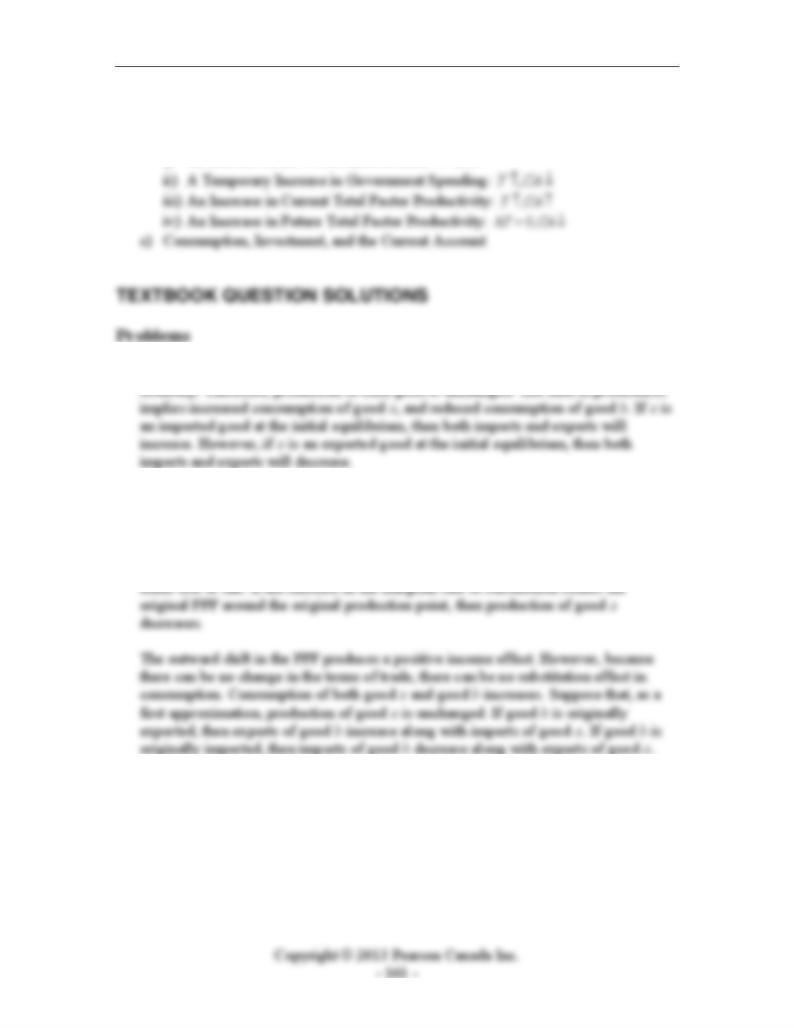
Chapter 15: International Trade in Goods and Assets
3. Production, Investment, and the Current Account
a) Output Supply and Output Demand
b) Effects of Disturbances
i) An Increase in the World Interest Rate: ,YCA↑↑
1. The change in preferences cannot change the terms of trade for a small open
2. If the marginal rate of transformation increases for every quantity of good a, then
there is a shift in the production possibilities frontier. In particular, there is no change
in the maximum amount of good b that can be produced, so there is no change in the
horizontal intercept. The rest of the PPF becomes steeper and lies everywhere else
above the original PPF. Production of good b increases, but production of good a may
3. Suppose that the economy starts out as in Figure 13.1, below. The economy produces
1
a units of good a and 1
b units of good b. Consumers consume 2
a units of good a and
2
b units of good b. The economy therefore exports good b and imports good a. Now
assume that a quota is placed on imports of good a, and that this quota is, in fact, a
binding constraint. Denote the size of the quota as 32
bb<.

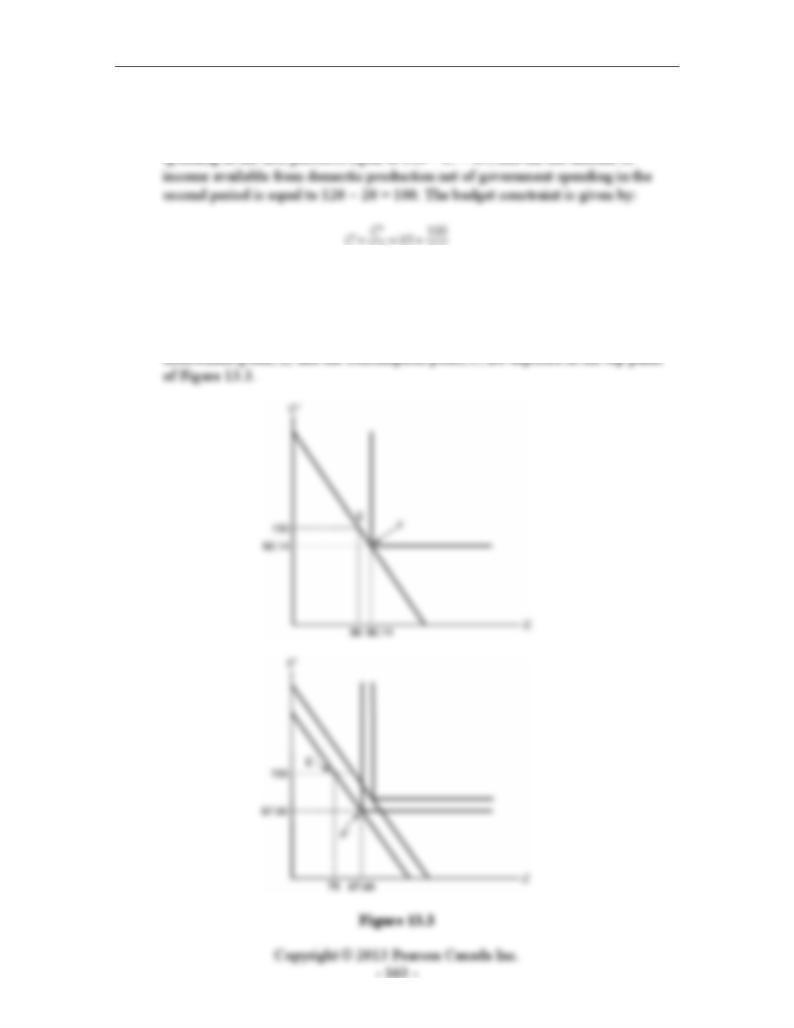
Chapter 15: International Trade in Goods and Assets
4. Government spending with perfect-complements preferences.
a) The net amount of income available from domestic production net of government
1.1 1.1
Setting first-period and second-period consumption equal, we find that
consumption in both periods is equal to 92.14. The current account surplus is
equal to domestic income (100) minus consumption (92.14) and minus
government spending (15), so the current account is equal to –7.14, a deficit. The
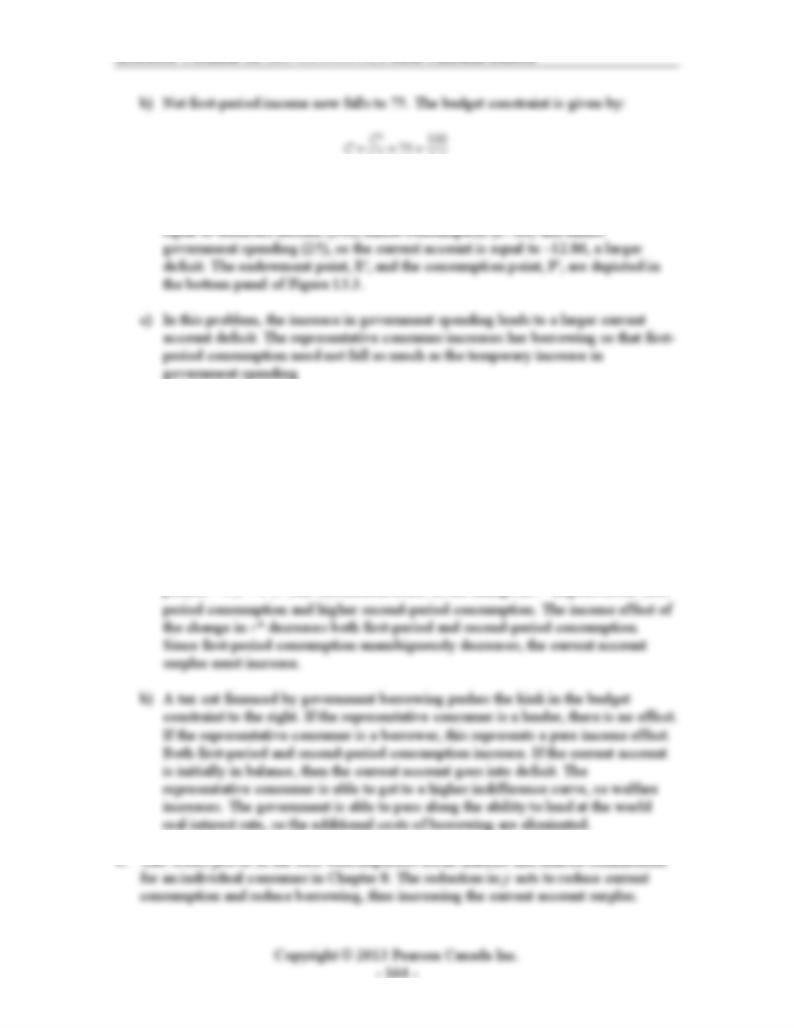
Instructor’s Manual for Macroeconomics, Fourth Canadian Edition
1.1 1.1
Setting first-period and second-period consumption equal, we find that
consumption in both periods is equal to 87.86. The current account surplus is
5. Different borrowing and lending rates.
a) For levels of first-period consumption less than Y – T, the consumer lends his
private savings, and earns the world real rate of interest, r. For levels of first-
period consumption greater than Y – T, the consumer must borrow at the higher
real rate of interest, r*. The representative consumer’s budget line is bowed out,
away from the origin. A change in r* makes the part of the budget line where
C > Y – T steeper. If the consumer was originally a saver, the change in r* has no
effect on consumption or the current account surplus. If the consumer was
originally a borrower, the budget-relevant portion of the line rotates through the
point (,'')YTYT−−. The substitution effect of the change in r* implies lower first-
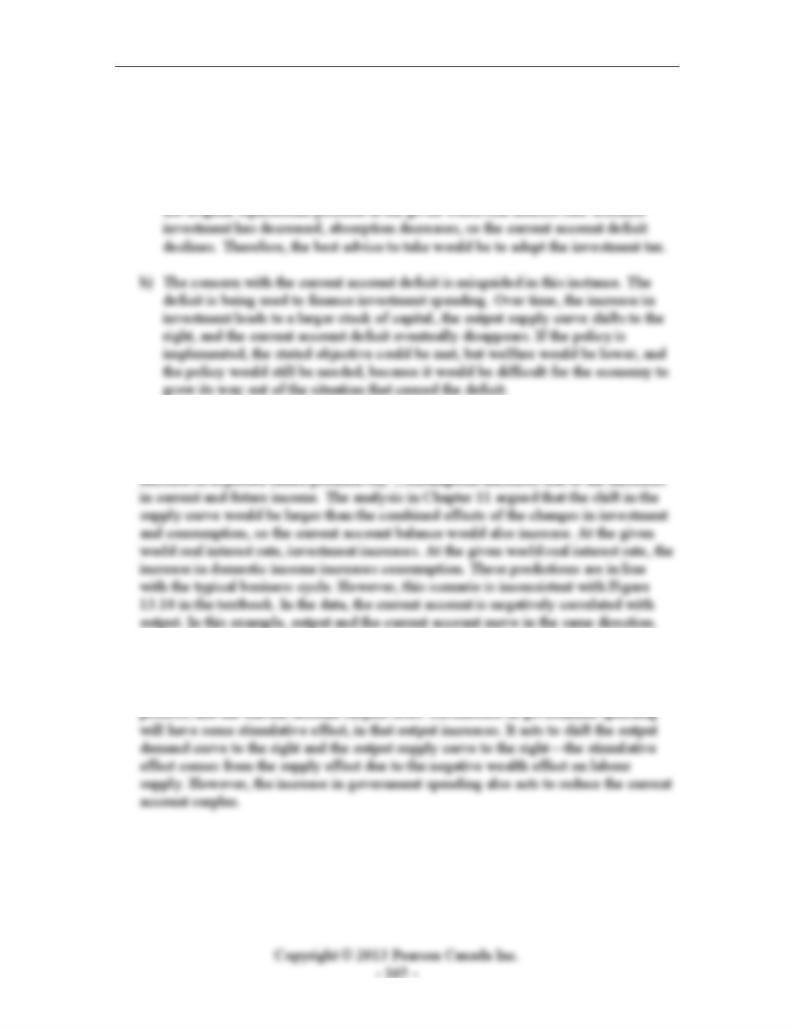
Chapter 15: International Trade in Goods and Assets
7. Current account deficit policies.
a) If Ricardian equivalence holds, then the level of lump-sum taxation has no effect
on the current account. The first group of advisors would therefore be wrong. A
tax on investment shifts the investment demand schedule to the left. The output
supply curve is unchanged. The output demand curve continues to pass through
8. A persistent increase in total factor productivity would shift both the output supply
curve and the output demand curve to the right. The supply curve shifts due to higher
employment and higher productivity. Investment demand increases due to the
9. An increase in investment spending generated by optimism about the future shifts the
output demand curve to the right and reduces the current account surplus, with no
effect on aggregate output. When investment spending falls, this just reverses the